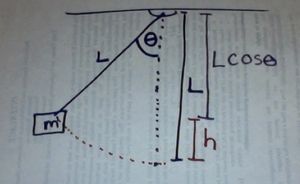write the energy changes take place if a pendulum Bob dragged to one side and then released to oscillate
In a simple pendulum with no friction, mechanical energy is conserved. Total mechanical energy is a combination of kinetic energy and gravitational potential energy. As the pendulum swings back and forth, there is a constant exchange between kinetic energy and gravitational potential energy.
The potential energy of the pendulum can be modelled off of the basic equation
PE = mgh
where g is the acceleration due to gravity and h is the height. We often use this equation to model objects in free fall.
However, the pendulum is constrained by the rod or string and is not in free fall. Thus we must express the height in terms of θ, the angle and L, the length of the pendulum. Thus h = L(1 – COS θ)

When θ = 90° the pendulum is at its highest point. The COS 90° = 0, and h = L(1-0) = L, and PE = mgL(1 – COS θ) = mgL
When the pendulum is at its lowest point, θ = 0° COS 0° = 1 and h = L (1-1) = 0, and PE = mgL(1 –1) = 0
At all points in-between the potential energy can be described using PE = mgL(1 – COS θ)
Ignoring friction and other non-conservative forces, we find that in a simple pendulum, mechanical energy is conserved. The kinetic energy would be KE= ½mv2,where m is the mass of the pendulum, and v is the speed of the pendulum.
At its highest point (Point A) the pendulum is momentarily motionless. All of the energy in the pendulum is gravitational potential energy and there is no kinetic energy. At the lowest point (Point D) the pendulum has its greatest speed. All of the energy in the pendulum is kinetic energy and there is no gravitational potential energy. However, the total energy is constant as a function of time.
If you have any more doubts just ask here on the forum and our experts will try to help you out as soon as possible.
Regards

